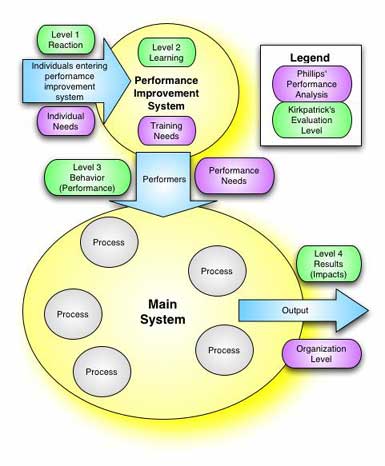Analysis
Analysis: The study we do in order to figure out what to do. - Allison Rossett & Kendra Sheldon (2001)
A performance analysis is generally called for when you want to improve a part of the organization (look for needs) or to fix a problem that someone has brought forth. Both are generally fixed in the same manner.
There are four performance improvement needs: Business, Job Performance, Training, and Individual (Phillips, 2002).
When performing an analysis, it is best to take a long term approach to ensure that the performance improvement initiative ties in with the organization's vision, mission, and values. This connects each need with a metric to ensure that it actually does what it is supposed to do. This is best accomplished by linking performance analysis needs with Kirkpatrick's Four Levels of Evaluations (Phillips, 2002):
- Business Needs are linked to Results or Impact (level 4)
- Job Performance Needs are linked to Behavior (level 3)
- Training Needs are linked to learning (level 2)
- Individual Needs are linked to Reaction (level 1)
By linking the analysis and evaluations models together, a total system concept is formed:

Analysis is performed to determine what is needed, thus it begins with a gap analysis: The "needs" of the organization minus the present performance level equals the gap.

Performance Improvement is a tool to bridge the performance gap
At this time, do not worry about how you are going to bridge the gap (creating content and context). Rather, the goal is to discover the present level of performance and the performance that is actually required. In addition, find out the "why." That is, what is causing the gap?
The Japanese have an interesting performance improvement concept — they ask "why" five times when confronted with a problem. By the time the fifth why is answered, they believe they have found the ultimate cause (root) of the problem. So when looking at a performance gap, look deep — “What exactly is causing the gap?”
Once you understand the problem (gap), then you need to see how it fits in with the various levels of the organization. The chart below shows the basic outline of a Performance Analysis and how Phillips' Four Needs and Kirkpatrick's Four Levels of Evaluations link in with Rummler & Brache's Three Level Performance Framework:
Click a topic on the map for more information on the subject
Backwards planning or more specifically, backwards analysis, should be used. That is, look at the broader goals of the organization and then work your way down to individual needs.
Business Needs
Investigate the problem or performance initiative and see how it supports the mission statement, leader's vision, and/or organizational goals, etc. Fixing a problem or making a process better is just as good as an ROI, if not better. Organizations that focus strictly on ROI are normally focusing on cost-cutting. And you can only cut costs so far before you start stripping out the core parts of a business. A much better approach is to improve a performance or process that supports a key organization goal, vision, or mission.
When senior executives were asked the most important training initiatives, 77% cited, “aligning learning strategies with business goals”; 75% cited, “ensuring learning content meets workforce requirements”; and 72%, “boosting productivity and agility” (Training Magazine, Oct 2004). Thus, senior leadership is not looking at training to be a profit center (that is what other business units are for), rather they are looking at performance improvement initiatives to help "grow" the organization so that it can reach its goals and perform its mission.
The goal is to make an impact or get some sort of result. So once you have identified the gap between present performance and the organization's goals and vision; create a level 4 evaluation (impact) that measures it — that is, what criteria must be met in order to show that the gap has actually been bridged?
To ensure you have accurately captured the Business Needs, the analysis must look at the needs of the Organizational Level and measure the Results or Impact.
Job Performance Needs
While the first analysis looked at business needs, this analysis looks at the job performance needs and these two needs could slightly differ. The first need, business, often has a slightly more visionary or future look to it, while the job performance need normally looks at what is needed now. Thus, business needs often tend to be more developmental in nature (future orientated), while job performance needs are normally more related towards the present.
This is perhaps the most important need to look at as it links the performer with the organization. When analyzing job performance, you want to look at the entire spectrum that surrounds the job: processes, environment, actual performance verses needed performance, etc, thus it often helps to divide the analysis into three groups: people, data, and things.
To ensure you have captured the Job Performance Needs, the analysis must look at the Process Level and measure the Performance (Behavior) of the job holders.
Some tools that should help are:
- Planning with Post-it Notes and Spreadsheets
- Performance Gaps
- Analysis Information
- Jobs and Tasks
- Tasks
- Analysis Templates (RTF file)
- Various Approaches to Needs Analysis
After assessing the business and job performance needs, you should have a pretty good idea of what needs to be fixed and future requirements. Analyze your findings and then start making plans for any needed performance interventions, such as training and development, job aids, coaching and mentor programs, process improvement, etc.
Training Needs
While Phillips named this part of the analysis Training Needs, a better term might have been Performance Intervention Need. That is, you need to think beyond training, and determine what type of performance intervention will actually bridge the performance gap.
As you assess the performance for any needed interventions, look at the Job/Performer requirements, that is, what the performer needs to know in order for the performance intervention to be successful. In addition, look at how you are going to evaluate any learning requirements (level 2). It is one thing to determine the learning needs (skill, knowledge, & self system [attitude, metacognition, etc.]), but it is quite another thing to ensure that those requirements actually take place.
Individual Needs
The Individual Needs Analysis is the identification of the target population. While this is closely related to the Training Need above, in that they both look at the Job/Performer Level, Individual needs go a little bit deeper. It ensures that the performance intervention actually conforms to the individual requirements. For example, in the Training Needs analysis, it might be determined that the job holders need to learn a new process. In this need analysis, the target population is looked at more closely to determine the actual content, context, and delivery method of the performance intervention.
In the Training Needs analysis, you look at learners as whole, while in this need analysis you look at them as individually as possible to determine Job/Performer levels. In addition, you want to determine how well this analysis was carried out by using a level one evaluation — Reaction. Throughout the training industry this evaluation is also known as smiley sheets — how well did the learners like the performance intervention. This is entirely the wrong thing to measure as it does not matter if the learners like it or not (although we normally do want to them to like it as they will normally learn and perform better). What matters the most is, "does it actually help them to improve their performance?" Thus, it needs to go beyond smiley sheets and actually measure their self-system.
Putting It All Together
The whole ideal behind the backwards analysis concept is to look at the system, identify a need, build an evaluation (measurement instrument) that identifies the objective that is required, identify the "why", select the intervention, and then build content and context that will bridge the gap between the need and the objective. Once you have a program in place, performing an evaluation should be a snap because you already have the measurement tools in place.
Reference
Phillips, J., Phillips, P. (2002). Reasons Why Training & Development Fails...and What You Can Do About It. Training Magazine, September 2002 (pp.78-85).
Rossett, A., Sheldon, K. (2001). Beyond the Podium: Delivering Training and Performance to a Digital World. San Francisco: Jossey-Bass/Pfeiffer, p. 67.
Rummler, G., Brache, A., (1990). Improving Performance: How to Manage the White Space on the Organization Chart. San Francisco: Jossey-Bass.
Training Magazine. (2004). Missing Artillery. Oct., p15.

